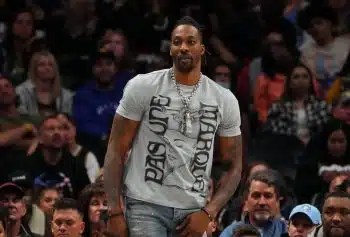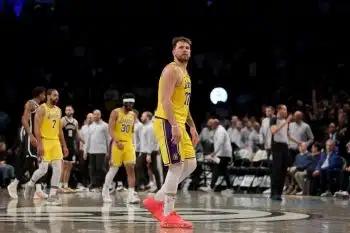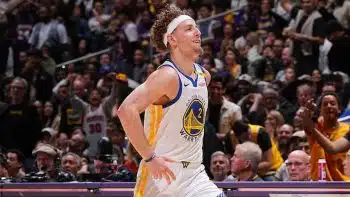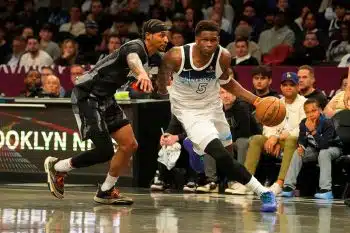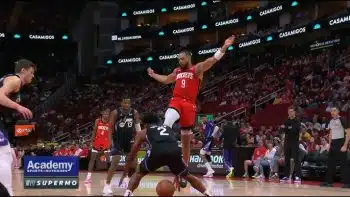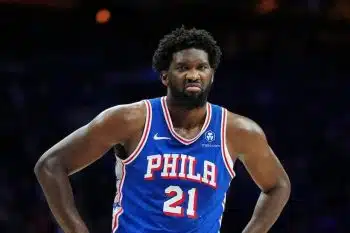NBA
The Russell Westbrook Contract Conundrum
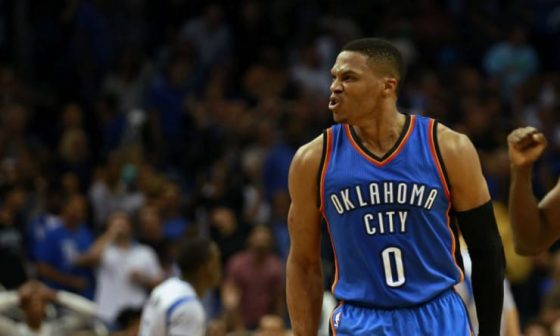
Almost immediately after Kevin Durant announced he was leaving Oklahoma City (well before the hot takes related to Durant’s decision had been extinguished), nervous OKC fans and pundits across the country began discussing what would happen to the Thunder as a result of this monumental turn of events.
Specifically, how would the franchise handle the impending free agency of Russell Westbrook?
If Westbrook is unwilling to commit to Oklahoma City before hitting the open market next summer, can General Manager Sam Presti and the Thunder take the chance that they might lose two future Hall-of-Famers in consecutive offseasons with absolutely nothing to show for it?
Surely Presti and company will have to at least explore the possibility of trading Westbrook this summer.
However, attempting to trade a star player with just one year left on his contract is always an arduous task. The Thunder could only realistically expect to get back cents on the dollar. It’s almost impossible to receive equal value in return when trading away a superstar, even under ideal circumstances. Having little to no leverage makes it that much more difficult.
The teams that are most commonly assumed to be pursuing Westbrook via trade (such as the Boston Celtics and Los Angeles Lakers) are obviously hesitant to fork over significant assets for what could result in simply a one-year rental; especially when the Celtics and Lakers are fully aware they’ll likely be able to make a push to sign Westbrook as an unrestricted free agent next summer.
Thus, it has been rumored that the Celtics would make Westbrook agreeing to a restructured extension a prerequisite to completing a blockbuster deal.
So, how likely it is that Westbrook actually would consider an extension?
Well, TNT’s David Aldridge reported in early July that there was “no chance” that Westbrook would agree to an extension.
Is that still the case?
Aldridge also tweeted that, “It just makes no sense financially to do renegotiation/extension.”
While the potential financial benefits of playing out the 2016-17 season and then hitting free agency next July are significant, it would be fiscally prudent for Westbrook to at least weigh the pros and cons of inking an extension.
If Westbrook knows where he wants to spend the prime of his career, agreeing to an extension would greatly increase the probability of his preferred destination trading for him now, as opposed to having to wait to relocate next summer.
It’s true that we rarely see extensions in today’s NBA, due primarily to the complexities of the current collective bargaining agreement. The first impediment is that only a limited number of veteran players qualify for such an extension. Per salary cap expert Larry Coon’s FAQ: “A contract for four or more seasons can be renegotiated after the third anniversary of its signing, extension, or previous renegotiation. Contracts for fewer than four seasons cannot be renegotiated. A contract cannot be renegotiated between March 1 and June 30 of any year.”
Westbrook, who has completed four seasons of his current contract, does have the ability to renegotiate and extend his contract, just as James Harden and the Houston Rockets did earlier this month. Would Westbrook be willing to follow Harden’s lead?
Let’s look at the financial implications of such a decision.
There are a number of varied options for Westbrook to consider. Each one offers a complex mix of positives and negatives. In the end, he’ll have to weigh the relative importance of immediate financial security and establishing roots sooner rather than later versus the appeal of a prodigious payday a bit further down the road.
The first, and seemingly most likely scenario, is refusing to renegotiate/extend his current contract. That means simply playing out the final year of his deal, the 2016-17 season, and hitting the market as an unrestricted free agent on July 1st, 2017.
Following the conclusion of the 2016-17 season, Westbrook will have nine NBA seasons under his belt, which means he will be a Tier 2 Free Agent (those players with between seven and nine years experience), and thus eligible to sign a contract with a starting salary that accounts for approximately 30 percent of the salary cap. (As Coon clarifies: maximum salaries are based on 42.14% of Basketball Related Income [BRI], rather than 44.74 percent. For this reason the maximum salaries are not actually 25 percent, 30 percent or 35 percent of the cap, and instead are a slightly lower amount.)
In early July our Eric Pincus reported that the NBA has informed teams that they anticipate the salary cap to land at $102 million next season.
Thus, Westbrook will be able to sign a contract next summer starting at roughly $28.8 million. If he was not traded, the Thunder would possess his full Bird Rights and they would be able to offer both more years (5) and larger annual percentages (7.5 percent).
Westbrook is currently scheduled to make $17.8 million this season. Here is what the max offer from OKC next July would look like (estimates based on a cap number of $102 million):
| 2016-17 | 2017-18 | 2018-19 | 2019-20 | 2020-21 | 2021-22 |
| $17.8 MM | $28.8 MM | $30.9 MM | $33.2 MM | $35.7 MM | $38.4 MM |
If a team such as the Celtics or Lakers traded for Westbrook this year they would also then possess his Bird Rights and could sign him to the same contract.
However, if Westbrook plays next season in Oklahoma City, and then signs elsewhere, a new (non-OKC) team would be unable to offer him the same lucrative package. Boston, for instance, would be able to offer a max contract of only four years in length with annual increases of just 4.5 percent.
Here’s the breakdown:
| 2016-17 | 2017-18 | 2018-19 | 2019-20 | 2020-21 |
| $17.8 MM | $28.8 MM | $30.1 MM | $31.5 MM | $32.9 MM |
Next summer, OKC (or whichever team controlled his Bird Rights) would be able to offer a max deal that sums to $167.0 million over five years. The max any other team could offer would be $123.3 million over four years.
Okay, with that as the baseline, let’s now look at the extension options on the table for Westbrook.
The benefit of a renegotiated extension is two-fold. First, Westbrook would be able to increase his 2016-17 salary from $17.8 million, all the way up to $26.5 million. Secondly, Westbrook would be able to immediately lock in a contract, which guaranteed him payment through 2020, thereby avoiding the risk of the catastrophic economic loss associated with a career-threatening injury suffered over the next 12 months.
However, there are some stipulations associated with extensions. Veteran extensions are limited to four seasons, including the seasons remaining on the current contract. Thus, Westbrook would only be able to lock in three additional seasons. So, while he’d be able to cushion himself from a worst-case scenario, he’d eliminate the potential of a big, long-term payday in July of 2017.
Another stipulation related to negotiated extensions is that the team signing Westbrook would need to have at least $8.8 million in cap space.
When Dion Waiters signed with Miami, his $12.8 million cap hold was wiped off OKC’s books, which means the Thunder now have the room required to tack on the additional $8.8 million to Westbrook’s deal.
If a team such as the Celtics were to receive confirmation from Westbrook’s agent that he would be willing to renegotiate/extend his current contract, they would need to clear the required cap space via trade to be able to offer a “max extension” as well.
Here is what restructured/renegotiated extension for Westbrook would look like:
| 2016-17 | 2017-18 | 2018-19 | 2019-20 |
| $26.5 MM | $28.3 MM | $30.4 MM | $32.7 MM |
Westbrook would secure approximately $118 million in guaranteed money the moment he signed the extension. He would miss out on the free agency bonanza of 2017, but he would only lose about $500,000 per year, when comparing his annual salary from 2017-18 through 2019-20. That’s a total of roughly $1.6 million over those three years. However, it is important to note that when you factor in the $8.8 million more he’d make in 2016-17, that’s a net gain of about $7.2 million ($117.9 MM vs. $100.7 MM) over the next four seasons.
There is one other of option Westbrook could consider. He could sign a shorter extension with guaranteed money in 2016-17 and 2017-18, but with a player option for the 2018-19 campaign. This would essentially be a compromise between playing out his final season, and signing a full four-year extension.
The Vertical’s Bobby Marks broke down this scenario in detail last week:
“Westbrook, currently with eight years of service, could renegotiate his salary for this season to reflect a max-level contract while adding two additional years, with the third being a player option. This approach would have Westbrook becoming a free agent in 2018, when he reaches 10 years of service and becomes a Tier 3 max player. Waiting another year for free agency would see Westbrook’s salary start at $35 million in 2018 instead of $28.6 million.”
| 2016-17 | 2017-18 | |
| $26.5 MM | $28.3 MM |
Then, in the summer of 2018, Westbrook (assuming he’s still healthy and can command a max contract) could opt out and would be able to sign a massive, mind-boggling five year contract worth north of $200 million, with the team that owned his Bird Rights at that point:
| 2018-19 | 2019-20 | 2020-21 | 2021-22 | 2022-23 |
| $35.4 MM | $38.1 MM | $40.8 MM | $43.4 MM | $46.1 MM |
******
There are clearly plenty of appealing options for Westbrook to choose from. His ultimate decision will have a massive impact on multiple franchises. However, Westbrook has yet to even publicly address his feelings regarding Durant’s departure, let alone his own foreseeable future.
Thus, the Oklahoma City Thunder will remain stuck at a fork in the road until Russell Westbrook decides which direction he wants to head in.
